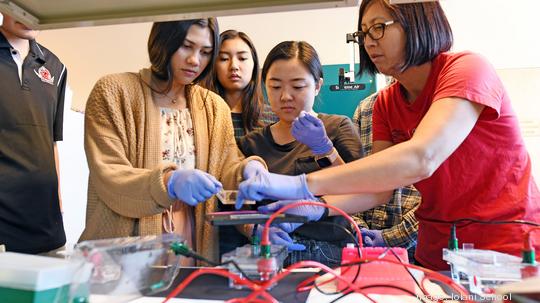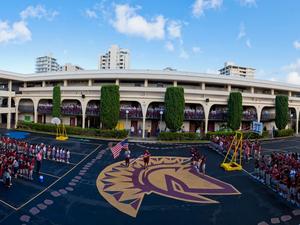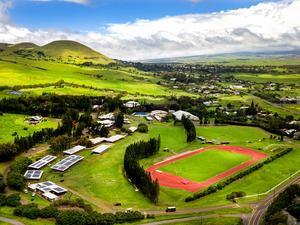
When you think back on your school days, you might remember sitting in certain classes wondering, “Am I ever going to use this in the real world?”
For the thousands of students who have participated in Iolani School’s Aina-Informatics Network, or AIN, and its Ala Wai Watershed Project, Na Wai Ekolu, the real world is their classroom and laboratory. Participating students have even contributing original research that has been published in scientific journals.
All this happens with a six-person team led by Director of Community Science Yvonne Chan, Ph.D, through Iolani’s Sullivan Center for Innovation and Leadership.
Chan said the Ala Wai watershed program, in place since 2010, has involved some 20,000 students.
AIN intends to teach genomics to Hawaii’s students and was founded in 2017 with a seed grant from the Edward E. Ford Foundation, which allowed Iolani to acquire the equipment and bring aboard genomics specialist Eric Tong, who had been a graduate student at the University of Hawaii at Manoa.
A $500,000 grant from Hawaii Dental Service, as well as a state government grant and a partnership with the Public Schools of Hawaii Foundation, have helped to bring the program into other private, public and charter schools, involving about 2,400 students so far.
For schools outside of Iolani, Chan’s team have developed a three-day curriculum.
“We bring everything to the school and work with the teacher to teach the students basic lab skills like pipetting, DNA extraction [and more],” Chan said.
“We’re collecting real world data [across] different projects that we work on [such as] our Covid Tracker project, where we’re partnering with Dr. Marguerite Butler at the University of Hawaii, and with the state Department of Health to sequence the Covid variants that are sampled from the Islands. It gives the students the experience of actually seeing how that Covid genome sequencing is done in the classroom.”
Iolani students on campus can participate in an extensive one-year program.
Technological innovation has been essential to making this kind of education possible, she said. Whereas sequencing the human genome 20 years ago required 10 years and $1 billion, Iolani is able to buy and provide to students hand-held genome sequencers that cost about $500 and deliver rapid results.
With those devices, and through partnerships with university researchers, high school students, students are gathering real data and making discoveries.
For example, a team of students at St. Andrew’s Priory were the first to sequence the genome of a newly discovered bacteria in the lava tubes of Hawaii Island. Being the first to do so, they even got to name it.
Other students have been sequencing E-DNA, or environmental DNA, which takes the cells sloughed off in streams by fish and sequences the DNA to measure the proportions of native to non-native fish in a given area.
Another student is analyzing the DNA found in the floating excrement of false killer whales, to better understand that creature’s diet — research that could have implications for the fisheries industries.
The scientific partnerships have even extended beyond the Islands. An Iolani alumnus, Jennifer Honda, now studies nontuberculous mycobacteria, or NTM, at National Jewish Health in Colorado. These organisms live in the environment and can cause tuberculosis-like illnesses.
“These lung diseases are not really curable and Hawaii has the highest rates of lung disease caused by nontuberculous mycobacteria in the country,” said Chan.
“Honda has been working with us on different community science projects where we have schools go out and help collect samples off of things like showerheads and faucets, to find the types of nontuberculous mycobacteria that are here and then sequence them.”
This work extends the research locally and nationally, and has resulted in publications of papers out of a conference on the topic held at Iolani.
The $235,000 grant from the state helped Iolani bring its curriculum to public schools on Kauai and Hawaii Island. Chan said the program aims to expand to Maui County schools next.
The program has been paying off not only in original research but in getting students to pursue STEM careers after high school.
“The goal is to bring it to kids so that they can see themselves doing this type of work, kind of lighting the fire underneath them,” Chan said.
“A theme of ours is, it’s private school for a public purpose. We want to be a resource and we want to share our resources because we’re very lucky with what we have and we’re really grateful for all the support that we’ve received to bring this to the community.”






